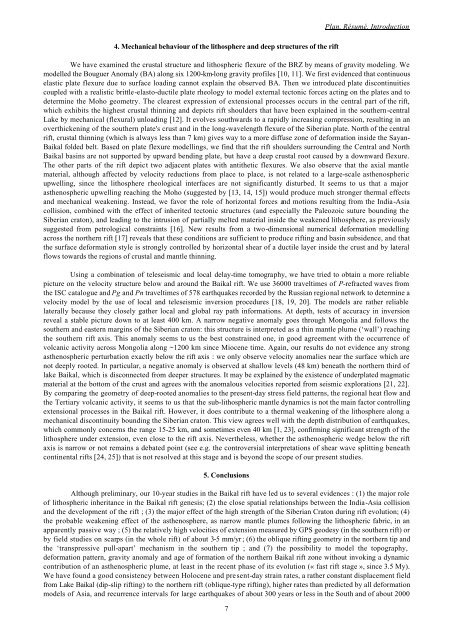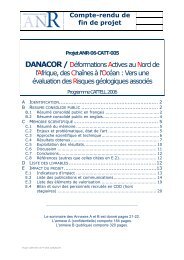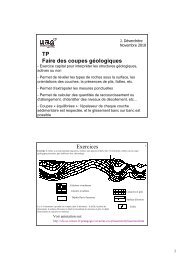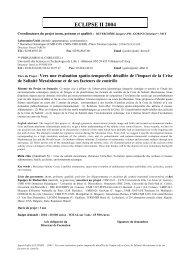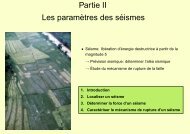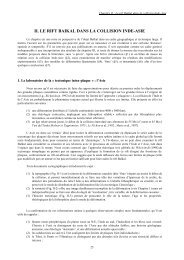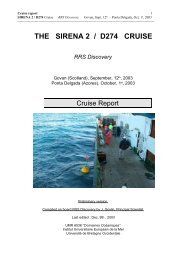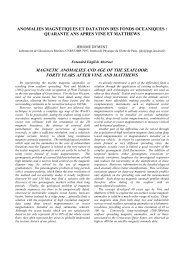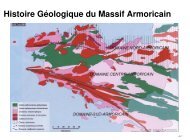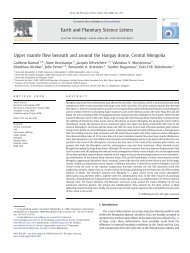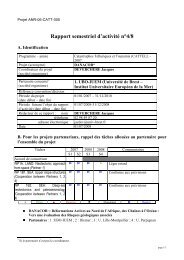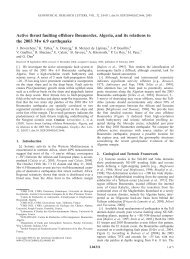Introduction - Remerciements - Plan - liste des personnes ayant une ...
Introduction - Remerciements - Plan - liste des personnes ayant une ...
Introduction - Remerciements - Plan - liste des personnes ayant une ...
Create successful ePaper yourself
Turn your PDF publications into a flip-book with our unique Google optimized e-Paper software.
4. Mechanical behaviour of the lithosphere and deep structures of the rift<br />
7<br />
<strong>Plan</strong>, Résumé, <strong>Introduction</strong><br />
We have examined the crustal structure and lithospheric flexure of the BRZ by means of gravity modeling. We<br />
modelled the Bouguer Anomaly (BA) along six 1200-km-long gravity profiles [10, 11]. We first evidenced that continuous<br />
elastic plate flexure due to surface loading cannot explain the observed BA. Then we introduced plate discontinuities<br />
coupled with a realistic brittle-elasto-ductile plate rheology to model external tectonic forces acting on the plates and to<br />
determine the Moho geometry. The clearest expression of extensional processes occurs in the central part of the rift,<br />
which exhibits the highest crustal thinning and depicts rift shoulders that have been explained in the southern-central<br />
Lake by mechanical (flexural) unloading [12]. It evolves southwards to a rapidly increasing compression, resulting in an<br />
overthickening of the southern plate's crust and in the long-wavelength flexure of the Siberian plate. North of the central<br />
rift, crustal thinning (which is always less than 7 km) gives way to a more diffuse zone of deformation inside the Sayan-<br />
Baikal folded belt. Based on plate flexure modellings, we find that the rift shoulders surrounding the Central and North<br />
Baikal basins are not supported by upward bending plate, but have a deep crustal root caused by a downward flexure.<br />
The other parts of the rift depict two adjacent plates with antithetic flexures. We also observe that the axial mantle<br />
material, although affected by velocity reductions from place to place, is not related to a large-scale asthenospheric<br />
upwelling, since the lithosphere rheological interfaces are not significantly disturbed. It seems to us that a major<br />
asthenospheric upwelling reaching the Moho (suggested by [13, 14, 15]) would produce much stronger thermal effects<br />
and mechanical weakening. Instead, we favor the role of horizontal forces and motions resulting from the India-Asia<br />
collision, combined with the effect of inherited tectonic structures (and especially the Paleozoic suture bounding the<br />
Siberian craton), and leading to the intrusion of partially melted material inside the weakened lithosphere, as previously<br />
suggested from petrological constraints [16]. New results from a two-dimensional numerical deformation modelling<br />
across the northern rift [17] reveals that these conditions are sufficient to produce rifting and basin subsidence, and that<br />
the surface deformation style is strongly controlled by horizontal shear of a ductile layer inside the crust and by lateral<br />
flows towards the regions of crustal and mantle thinning.<br />
Using a combination of teleseismic and local delay-time tomography, we have tried to obtain a more reliable<br />
picture on the velocity structure below and around the Baikal rift. We use 36000 traveltimes of P-refracted waves from<br />
the ISC catalogue and Pg and Pn traveltimes of 578 earthquakes recorded by the Russian regional network to determine a<br />
velocity model by the use of local and teleseismic inversion procedures [18, 19, 20]. The models are rather reliable<br />
laterally because they closely gather local and global ray path informations. At depth, tests of accuracy in inversion<br />
reveal a stable picture down to at least 400 km. A narrow negative anomaly goes through Mongolia and follows the<br />
southern and eastern margins of the Siberian craton: this structure is interpreted as a thin mantle plume (‘wall’) reaching<br />
the southern rift axis. This anomaly seems to us the best constrained one, in good agreement with the occurrence of<br />
volcanic activity across Mongolia along ~1200 km since Miocene time. Again, our results do not evidence any strong<br />
asthenospheric perturbation exactly below the rift axis : we only observe velocity anomalies near the surface which are<br />
not deeply rooted. In particular, a negative anomaly is observed at shallow levels (48 km) beneath the northern third of<br />
lake Baikal, which is disconnected from deeper structures. It may be explained by the existence of underplated magmatic<br />
material at the bottom of the crust and agrees with the anomalous velocities reported from seismic explorations [21, 22].<br />
By comparing the geometry of deep-rooted anomalies to the present-day stress field patterns, the regional heat flow and<br />
the Tertiary volcanic activity, it seems to us that the sub-lithospheric mantle dynamics is not the main factor controlling<br />
extensional processes in the Baikal rift. However, it does contribute to a thermal weakening of the lithosphere along a<br />
mechanical discontinuity bounding the Siberian craton. This view agrees well with the depth distribution of earthquakes,<br />
which commonly concerns the range 15-25 km, and sometimes even 40 km [1, 23], confirming significant strength of the<br />
lithosphere under extension, even close to the rift axis. Nevertheless, whether the asthenospheric wedge below the rift<br />
axis is narrow or not remains a debated point (see e.g. the controversial interpretations of shear wave splitting beneath<br />
continental rifts [24, 25]) that is not resolved at this stage and is beyond the scope of our present studies.<br />
5. Conclusions<br />
Although preliminary, our 10-year studies in the Baikal rift have led us to several evidences : (1) the major role<br />
of lithospheric inheritance in the Baikal rift genesis; (2) the close spatial relationships between the India-Asia collision<br />
and the development of the rift ; (3) the major effect of the high strength of the Siberian Craton during rift evolution; (4)<br />
the probable weakening effect of the asthenosphere, as narrow mantle plumes following the lithospheric fabric, in an<br />
apparently passive way ; (5) the relatively high velocities of extension measured by GPS geo<strong>des</strong>y (in the southern rift) or<br />
by field studies on scarps (in the whole rift) of about 3-5 mm/yr ; (6) the oblique rifting geometry in the northern tip and<br />
the ‘transpressive pull-apart’ mechanism in the southern tip ; and (7) the possibility to model the topography,<br />
deformation pattern, gravity anomaly and age of formation of the northern Baikal rift zone without invoking a dynamic<br />
contribution of an asthenospheric plume, at least in the recent phase of its evolution (« fast rift stage », since 3.5 My).<br />
We have found a good consistency between Holocene and present-day strain rates, a rather constant displacement field<br />
from Lake Baikal (dip-slip rifting) to the northern rift (oblique-type rifting), higher rates than predicted by all deformation<br />
models of Asia, and recurrence intervals for large earthquakes of about 300 years or less in the South and of about 2000


